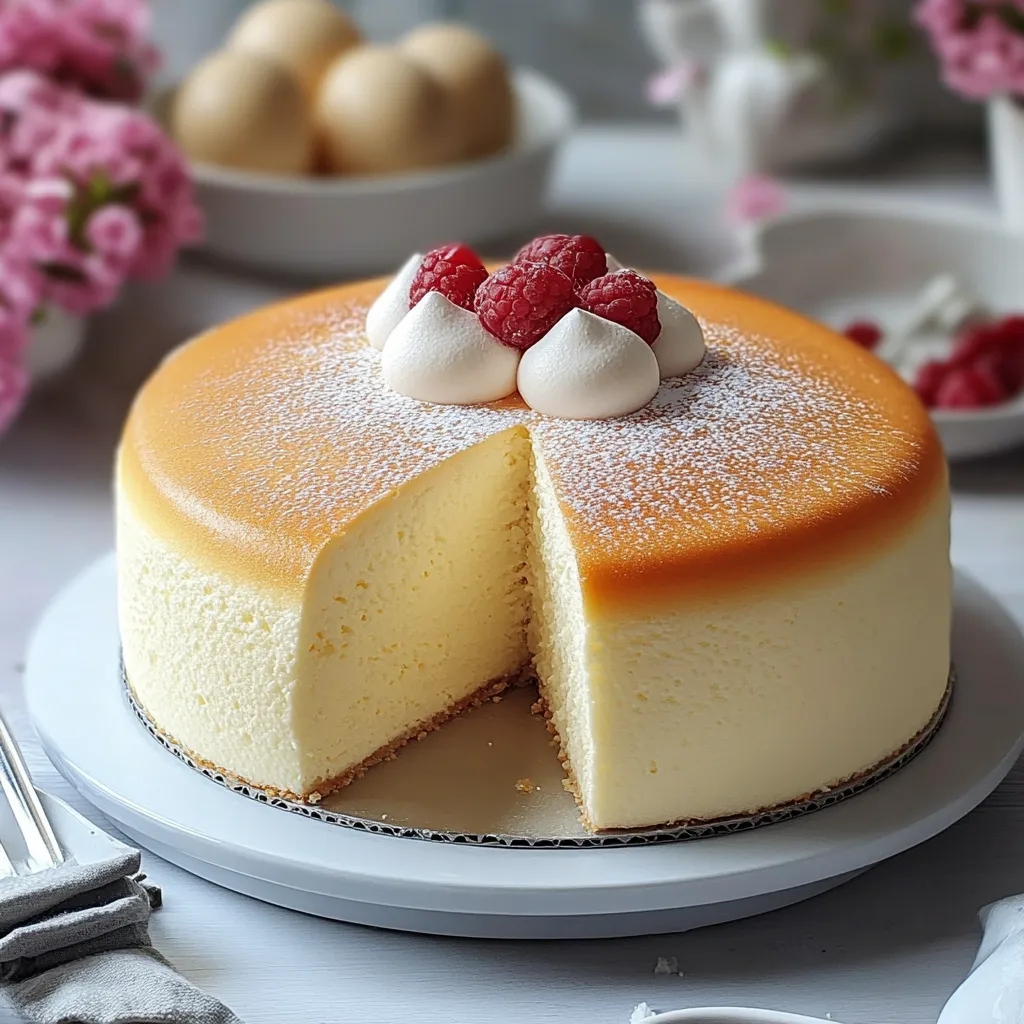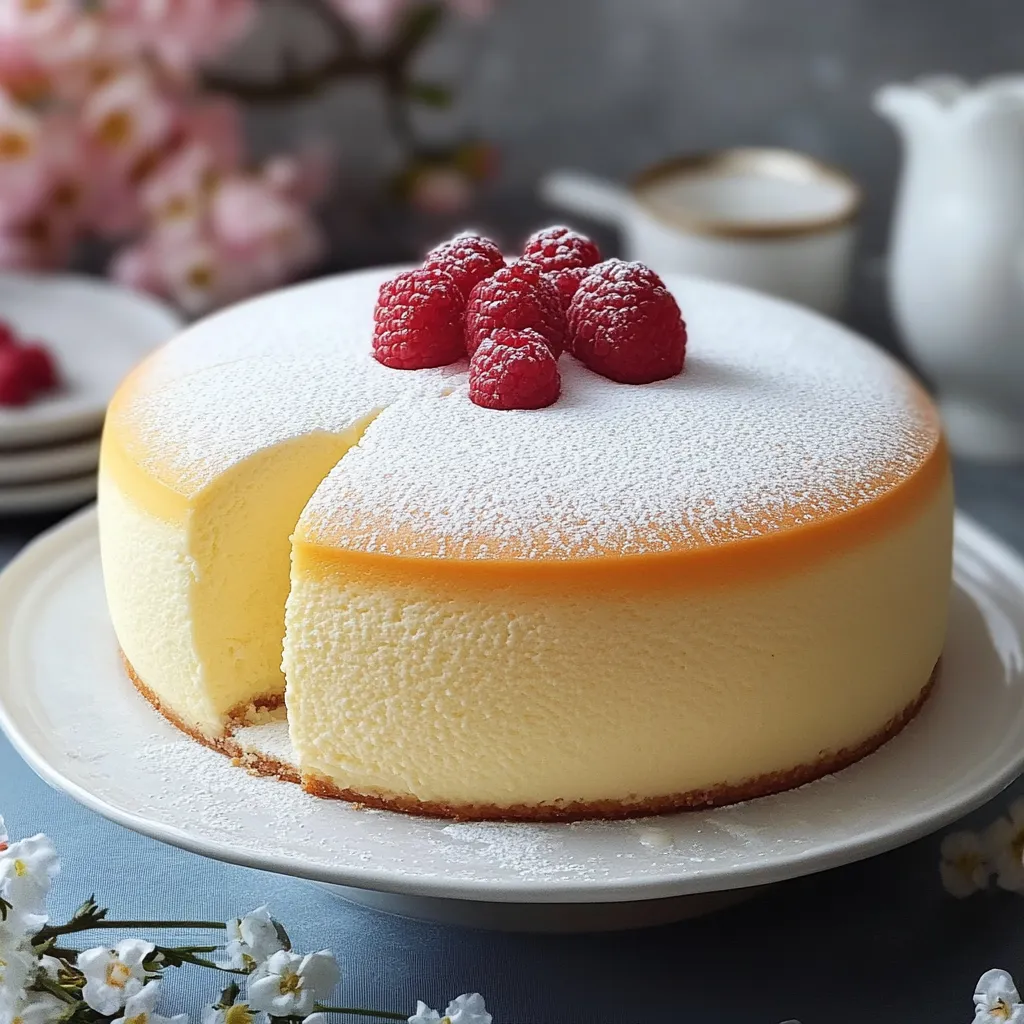 Pin it
Pin it
The moment you slice into a Fluffy Japanese Cheesecake, you witness culinary magic unfold before your eyes. This extraordinary dessert captures hearts with its impossibly light texture that quivers with the gentlest touch, yet holds its shape beautifully on your plate. Unlike traditional American cheesecakes with their dense, creamy consistency, Japanese cheesecake marries the tangy richness of cream cheese with the ethereal lightness of perfectly executed soufflé. Each bite delivers a subtle sweetness that dissolves effortlessly on your tongue, leaving you reaching for another forkful before you've even finished the first.
I discovered this recipe during my culinary travels through Tokyo, where I watched in awe as a local pastry chef demonstrated the meticulous technique behind this beloved treat. After multiple attempts in my home kitchen, I finally mastered the delicate balance of ingredients and timing required to achieve that signature wobble. My family now requests this cheesecake for every special occasion, preferring its gentle sweetness to heavier dessert options.
Essential Elements
- Cream cheese: Select premium full-fat varieties at room temperature for seamless incorporation without lumps
- Eggs: Fresh eggs separated meticulously without any yolk contamination ensure proper meringue formation
- Cake flour: The lower protein content creates tenderness impossible to achieve with all-purpose alternatives
- Lemon juice: Beyond adding subtle brightness, it stabilizes the egg whites for more reliable peaks
Preparation Journey
- Water bath preparation:
- Create a protective environment by double-wrapping your springform pan with heavy-duty aluminum foil, ensuring no seams where water might penetrate.
- Cream cheese foundation:
- Beat softened cream cheese patiently until completely smooth before incorporating sugar gradually, preventing any textural disruptions in your final cake.
- Yolk enrichment:
- Incorporate egg yolks one at a time, allowing each to fully integrate before adding the next, building a stable emulsion.
- Liquid incorporation:
- Add milk and flavoring extracts slowly while mixing at low speed to maintain the emulsion without introducing excessive air.
- Dry ingredient sifting:
- Carefully fold sifted cake flour and cornstarch using a cutting motion that preserves the developed structure while ensuring no dry pockets remain.
- Meringue mastery:
- Whip room temperature egg whites with cream of tartar until foamy before gradually adding sugar, watching for glossy, firm peaks that barely droop.
- Gentle amalgamation:
- Incorporate meringue in three portions, using the lightest possible touch with a large spatula to maintain maximum volume.
- Baking strategy:
- Place in water bath and bake at moderate temperature, allowing the structure to set gradually without excessive browning or cracking.
- Cooling discipline:
- Prevent collapse by cooling gradually in the turned-off oven with door slightly ajar before transferring to room temperature.
 Pin it
Pin it
My grandmother visited from Japan shortly after I perfected this recipe. Though she rarely offered praise for Western-influenced desserts, she closed her eyes with pleasure after the first bite and simply whispered 'oishii' (delicious). This moment confirmed I had truly captured the authentic essence of this special treat that bridges culinary traditions.
Flavor Variations
Expand your Japanese cheesecake repertoire by experimenting with flavor variations that maintain the delicate texture while introducing new dimensions. Traditional matcha powder transforms both color and flavor, creating an elegant green tea version perfect for formal tea gatherings. Citrus enthusiasts appreciate the bright notes introduced by incorporating fresh yuzu or Meyer lemon zest throughout the batter. Vanilla bean paste adds visible flecks and aromatic complexity impossible to achieve with extract alone.
 Pin it
Pin it
My journey with Japanese cheesecake began as curiosity about a viral video but transformed into profound respect for the precision and balance inherent in Japanese baking traditions. Each time I prepare this recipe, I appreciate anew the beautiful simplicity that requires such technical skill to achieve. The reward comes not just from creating something visually stunning, but from watching friends and family experience that first magical bite—the moment of surprise when they discover this isn't the cheesecake they expected, but something far more extraordinary.
Frequently Asked Questions
- → Why did my Japanese Cheesecake crack on top?
- Cracking usually happens due to sudden temperature changes. Make sure to cool the cheesecake gradually by leaving it in the oven with the door slightly open after baking. Also, ensure your oven temperature is accurate and that you're using a proper water bath.
- → Can I make Fluffy Japanese Cheesecake without a water bath?
- The water bath is essential for Japanese Cheesecake as it provides gentle, even heat that helps the cake rise properly without cracking. Without it, the texture would be denser and less fluffy, and the cake would likely crack on top.
- → Why did my Japanese Cheesecake deflate after baking?
- Some slight deflation is normal, but significant sinking typically happens when the egg whites weren't beaten to stiff enough peaks, the batter was overmixed and lost air, or the cake was removed from the oven too quickly. The gradual cooling process is crucial for maintaining structure.
- → Can I use all-purpose flour instead of cake flour?
- Yes, you can substitute all-purpose flour, but the texture won't be quite as light. If using all-purpose flour, replace the 60g cake flour with 54g all-purpose flour mixed with 6g cornstarch, sifted together before using.
- → How should I store leftover Japanese Cheesecake?
- Store leftover Japanese Cheesecake in an airtight container in the refrigerator for up to 3 days. The texture becomes more cake-like when chilled. You can bring it to room temperature for about 20 minutes before serving if you prefer a softer texture.
